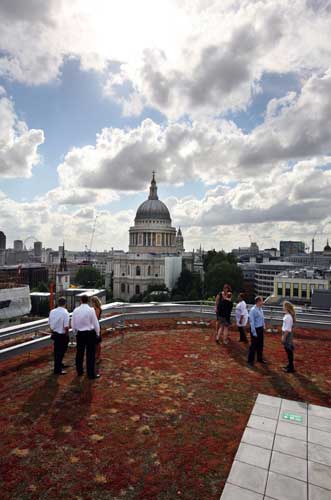In central London there is a lawn of luscious green, in which insects merrily scurry. Feeding on them are birds, which can nest nearby in specially installed wooden boxes. They are observed by office workers eight storeys above ground level, where a view of Saint Paul's Cathedral matches any vista in the capital.
This glorious scene takes place on the top floor of the recently completed headquarters of law firm Eversheds. The building, contrary to what you might expect from a conventional office block for grey-suited solicitors, is one of the greenest in the capital. In this edifice, there are no swathes of air conditioning units and energy-wasting lighting. Instead, the office has the biggest green roof in London and features an abundance of other eco-friendly features. The £11m landmark joins a host of other environmentally sensitive office buildings springing up all over the country.
The idea to make One Wood Street green was spearheaded by Eversheds' senior partners, according to the building's project manager, Gareth Griffiths, of construction consultancy Capita Symonds. "It was a conscious decision to enhance the green credentials of the building because the consensus in the City is that we have to be responsible members of society," he says. "Offices are a significant contributor to carbon dioxide emissions because of their high energy consumption. A high-profile firm such as Eversheds can make a considerable impact on that. Additionally, the environment is becoming an important issue to clients, and so having an office which follows green ideals leads by example."
The green roof, which can be visited by employees on request, is made of a spongy roll of the succulent plant, sedum. It is durable and needs no watering. "Mud baths" will be added, to encourage a roof-level "mini-ecosystem" in which insects provide food for birds. It is hoped the bird boxes will attract peregrine falcons – which have nested at nearby Tate Modern – swifts, and redstarts.
Such eco-consciousness is proving popular with employees. Bo Kehinde, a solicitor at the company says: "The green roof is wonderful to be associated with. Up there it is quite tranquil. The sedum is low and soft to walk on and it is a peaceful place."
The building's designer, Ray Holden of Fletcher Priest Architects, says green roofs are increasingly becoming a coveted addition to modern offices. "Roofs are often wasted spaces. It is a whole floor that people build that is never normally used," he explains. "But we can be more responsible as designers by using them in a green way. Conventional roofs absorb a large amount of heat, making London hotter. But because green roofs are full of water, which evaporates when heated, they make the city a lot cooler. And they also bring in wildlife."
But "greenness" is not confined to the roof at One Wood Street. Clever gizmos are peppered across all of the building's 160,000 square feet. These minimise power consumption and include intelligent lighting, which senses when people are absent from the office floor and switches itself off accordingly. And "Chilled beams" – long oblongs of hollow metal containing water, provide an energy-efficient method of cooling, having no moving parts. Indeed, it is so quiet with the beams, compared with the hum of air conditioning, that artificial noise is pumped into the Eversheds HQ. This is to muffle conversations – an important factor if confidential deals are being discussed. But the open plan design also means less power is used. Instead of many rooms, each with their own lighting and temperature controls, there is just one.
One Wood Street is at the forefront of a wave of offices winning or set to win plaudits for their environmental credentials. They include another office by Fletcher Priest, London's Watermark Place, also in the City, to be finished next year, which also will boast a large green roof. And then there is the new headquarters for PricewaterhouseCoopers, to be built on the More London development, next to Tower Bridge, by 2010. While it doesn't have a green roof, it will have hot water heating by solar energy.
These projects will join the National Trust's headquarters in Swindon (which is naturally ventilated) and the Wessex Water building in Bristol, which uses a third of the energy normally consumed by an office building. Its makes use of solar power and minimises artificial heating.
"Sustainability has gripped the office community, I have never known anything like it," says Richard Kauntze, chief executive of the British Council for Offices, which advises on best practice for designers, operators and managers. "It's what everyone is talking about. The buildings we live and work in use massive amounts of energy. There is a real desire to change and a clear acceptance that the way offices have been designed and managed cannot continue. The bigger challenge is with existing buildings. Computers, lights and heating should all be reduced; that can make a big difference and can cost very little."
Turf at the top
1. The Office Group, Gray's Inn Road, London
A green roof for meetings or lunch, and provides a useful habitat for insects. Also features an outdoor classroom for children from the local area.
2. Norfolk Community Primary School, Sheffield
Built as a condition of planning permission due to storm-water overflow problems. The roof has lowered the likelihood of vandalism, and improved rainwater management.
3. Moorgate Crofts Business Centre, Rotherham
When the business centre's management decided they wanted conference rooms on the roof, a green roof was used to create sustainable surroundings.
For more information on green roofs see www.livingroofs.org
Subscribe to Independent Premium to bookmark this article
Want to bookmark your favourite articles and stories to read or reference later? Start your Independent Premium subscription today.


Join our commenting forum
Join thought-provoking conversations, follow other Independent readers and see their replies